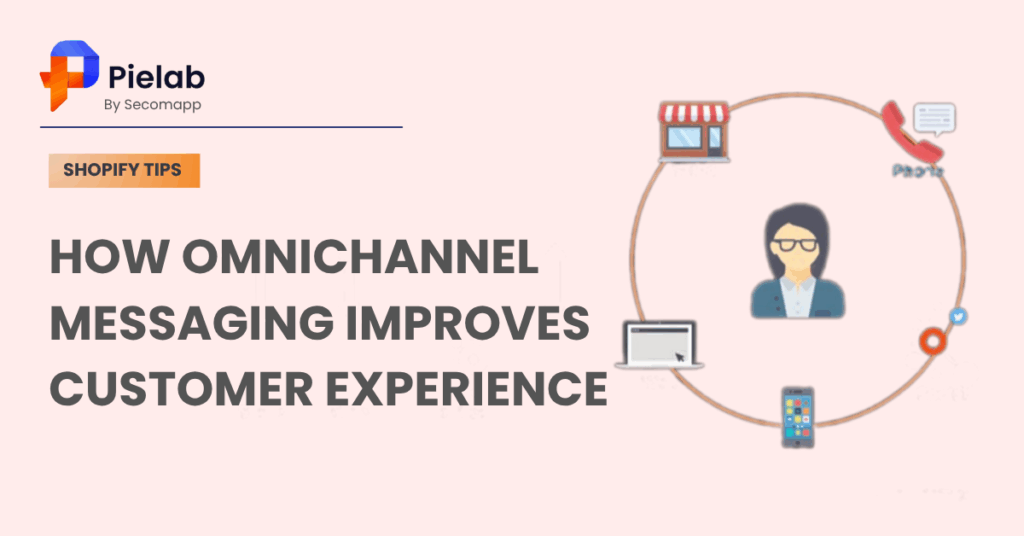What is omnichannel messaging?
Omnichannel messaging is a customer-focused strategy that unifies all communication channels onto a single platform. This enables brands to synchronize data across various channels and see and reply to conversations.
Businesses can send messages from various channels (such as web chat, SMS, and social media) in one place with omnichannel messaging platforms. Customer satisfaction, sales cycle speed, and brand reputation are all greatly enhanced by this coordinated communication.
Omnichannel vs. multichannel: What’s the difference?
Omnichannel messaging, which is sometimes mistaken for multichannel messaging, provides a more cohesive customer experience that is centered on customer engagement. While omnichannel approaches are focused on the customer, multichannel strategies are focused on the product.
Companies that employ a multichannel strategy respond to consumer communications via each separate channel rather than having access to a single backend. This implies that if a customer communicates with a representative via Facebook Messenger, another representative replying to customers via SMS will not be able to view their conversation history.
4 Benefits of omnichannel messaging
Let’s take a look at four key benefits of omnichannel messaging.
1. Enhanced customer experience and retention rates
When customers receive cohesive, timely communication across their preferred channels, it creates a smoother and more satisfying experience — leading to stronger loyalty. In fact, businesses using omnichannel messaging retain nearly 89% of their customers, compared to just 33% for those without such a strategy.
With customer data centralized across platforms, every interaction — whether through chat, email, or phone — feels informed and personalized. This empowers support teams with up-to-date insights and removes friction from the buyer journey.
2. Unified and Trustworthy Brand Messaging
By consolidating all messaging into a single, integrated system, brands ensure their tone, style, and information remain consistent. This avoids sending mixed messages, reduces redundancy, and builds customer confidence.
Consistency also reinforces brand identity — helping customers recognize your values and messaging, no matter which channel they use.
3. Stronger Competitive Positioning
As customer expectations grow, brands that deliver personalized, connected experiences across all touchpoints gain a significant edge. Omnichannel messaging sets these businesses apart by providing service that feels smooth, modern, and tailored.
In addition to enhancing the user experience, this approach strengthens the brand’s image — showing customers and competitors alike that your business is organized, responsive, and ready to meet them wherever they are.
4. Deeper Customer Insights
Omnichannel messaging allows brands to collect and unify data from multiple sources — including website behavior, chat transcripts, and purchase history — to create a complete view of each customer.
This enriched data supports semantic keyword clustering and personalized targeting, ultimately driving better experiences and SEO automation opportunities.
5 Ways Omnichannel Messaging Enhances Customer Experience
1. Consistency Across Channels
Customers expect the same tone, offer, and messaging whether they’re reading your email, chatting with your team, or browsing your app. Inconsistent messaging leads to confusion and mistrust.
Omnichannel messaging ensures that all touchpoints — from promotions to customer support — tell the same story. This unified brand experience makes every customer interaction feel familiar and trustworthy.
2. Real-Time, Contextual Conversations
Modern consumers want instant, relevant communication. They don’t want to explain their issue twice, or get generic messages that don’t reflect their behavior.
With omnichannel systems in place, a customer who starts a conversation on live chat and switches to email won’t lose continuity. The context follows them. Support agents can immediately pick up where the last message left off, reducing frustration and showing that the business understands their needs.
3. Faster Problem Resolution
Nothing damages CX faster than slow or repetitive support. In siloed systems, customer service reps often lack visibility into previous interactions — forcing customers to repeat themselves.
Omnichannel messaging changes that. When all data is connected, agents can quickly see a customer’s purchase history, past issues, and recent activity. This saves time on both sides and leads to faster resolutions — which boosts satisfaction and reduces churn.
4. Personalized Interactions at Scale
With data flowing freely between channels, businesses can deliver highly personalized messaging. For instance:
- A returning customer receives a product recommendation based on their browsing behavior.
- An abandoned cart triggers a timely SMS reminder.
- A user who hasn’t engaged in 30 days gets a reactivation email.
Every message feels thoughtful and relevant — creating an experience that resonates with the customer and increases their likelihood to convert.
5. Trust and Loyalty Over Time
The end goal of customer experience is not just one-time satisfaction — it’s long-term loyalty. Omnichannel messaging builds this by making customers feel seen, heard, and remembered.
When customers can move from platform to platform without losing context — and consistently receive helpful, personalized interactions — they are more likely to return, recommend, and advocate for your brand.
Essential Channels for an Omnichannel Messaging Strategy

When building an effective omnichannel messaging strategy, it’s important to incorporate a variety of communication channels that align with customer behavior and preferences. Here are some of the most impactful ones:
Live Chat
Live chat enables businesses to resolve customer inquiries instantly, delivering a smooth and efficient support experience. Unlike phone calls or emails, customers can ask questions, get recommendations, or speak with a representative without long wait times. Studies show that integrating live chat can boost website conversion rates by up to 20%.
SMS and MMS
SMS open rates are as high as 98%. Use them for reminders, exclusive deals, or index backlinks to new landing pages. For best practices, explore Google’s free listings guide.
Email remains a cornerstone of customer communication — ideal for sharing product updates, announcements, and content-rich newsletters. Rather than sending standalone promo codes, consider embedding offers in engaging emails with added value. Bonus: email is cost-efficient and supports automation and personalization at scale.
Social Media
Platforms like Facebook, Instagram, LinkedIn, and X (formerly Twitter) are essential touchpoints throughout the customer journey. These channels not only allow brands to share consistent visual messaging but also create opportunities for real-time interaction. Features like comments, story polls, and direct messaging help businesses connect naturally with their audiences and maintain a unified brand presence.
Chat Apps
Messaging apps like WhatsApp and Facebook Messenger are now must-haves for global customer communication. With billions of users worldwide, these platforms make your business more accessible — especially in regions where SMS is limited or costly. Plus, they’re budget-friendly for both brands and customers.
In-App Messaging
If your company offers a mobile app, in-app messaging is a powerful way to keep users engaged. It allows customers to reach out without leaving the app, removing friction in the buying journey and increasing time spent on your platform — both of which can boost conversions.
How to choose an omnichannel messaging platform

Choosing the right omnichannel messaging platform is a key step toward delivering seamless, personalized experiences. Start by ensuring the platform supports the communication channels your customers use most — including email, SMS, live chat, push notifications, and social media. More importantly, these channels should be connected so conversations can move smoothly from one to another without losing context.
Next, prioritize platforms that offer a unified customer view, allowing your teams to access full interaction history and behavioral data in one place. Strong integration capabilities are also essential — the platform should work well with your existing CRM, eCommerce platform, or helpdesk tools to avoid data silos.
Finally, look for features that support scalability and automation, such as message scheduling, segmentation, and real-time analytics. And don’t overlook usability — the best platform is one that your team can adopt easily, with intuitive workflows and dedicated onboarding support.
Conclusion
Omnichannel messaging isn’t just a tactic — it’s a mindset that puts the customer at the center of every interaction. As customer expectations continue to rise, businesses that adopt this approach will not only stand out but thrive.
When messaging is consistent, relevant, and connected across channels, the customer experience improves — and your brand earns lasting trust.


